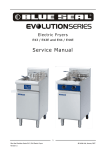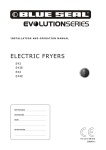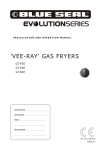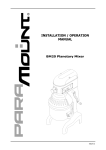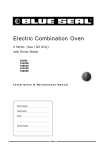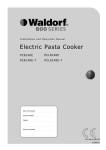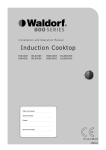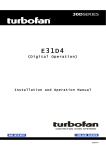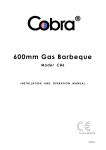Download Blue Seal E603 Specifications
Transcript
E603 E604 ELECTRIC FRYERS 16191-20 MANUFACTURED BY Moffat Limited Christchurch New Zealand INTERNATIONAL CONTACTS AUSTRALIA Moffat Pty Limited E.Mail: Main Office: Service: Spares: Customer Service: [email protected] (tel): +61 (03) 9518 3888 (fax): +61 (03 9518 3833 (tel): 1800 622 216 (tel): 1800 337 963 (tel): 1800 335 315 (fax): 1800 350 281 CANADA Serve Canada Web: E.Mail: Sales: Service: www.servecanada.com [email protected] (tel): 800 551 8795 (Toll Free) (tel): 800 263 1455 (Toll Free) NEW ZEALAND Moffat Limited Web: E.Mail: Main Office: www.moffat.co.nz [email protected] (tel): 0800 663328 UNITED KINGDOM Blue Seal Web: E.Mail: Sales: Spares: Service: www.blue-seal.co.uk [email protected] (tel): +44 121 327 5575 (fax): +44 121 327 9711 (tel): +44 121 322 6640 (fax): +44 121 327 9201 (tel): +44 121 322 6644 (fax): +44 121 327 6257 UNITED STATES Moffat Web: Sales: Service: www.moffat.com (tel): 800 551 8795 (Toll Free) (tel): +1 336 661 1556 (fax): +1 336 661 9546 (tel): 800 858 4477 (Toll Free) (tel): +1 366 661 1556 (fax): +1 336 661 1660 REST OF WORLD Moffat Limited Web: E.Mail: www.moffat.co.nz [email protected] The reproduction or copying of any part of this manual by any means whatsoever is strictly forbidden unless authorized previously in writing by the manufacturer. In line with policy to continually develop and improve its products, Moffat Ltd. reserves the right to change the specifications and design without prior notice. © Copyright Moffat Ltd. August 2011. BLUE SEAL DEEP FRYER CONTENTS PAGE INTRODUCTION 5 INSTALLATION 6 COMMISSIONING 7 CONTROLS 8 OPERATION Care of Oil / Fats Cooking Problems 9 11 12 CLEANING 15 CIRCUIT SCHEMATIC 17 PARTS LIST 18 Date Purchased................................................................................ Serial No.......................................… Dealer........................................................................................................................................................... Service Agent............................................................................................................................................... INTRODUCTION We are pleased you chose to purchase a BLUE SEAL fryer. To ensure you receive the utmost benefit from your new fryer, there are two things you can do. FIRSTLY Please read this instruction book carefully and follow the directions given. The time taken will be well spent. SECONDLY If you are unsure of any aspect of the installation, instructions or performance of your fryer, contact you BLUE SEAL dealer. WARNING Because fryers are used in extremely arduous environments, no manufacturer, even after taking every possible precaution, can guarantee the operation of the equipment to be infallible. Great care must be taken by the operator to use the equipment safely, to make sure it is regularly serviced and in every possible way to guard against risk of fire. * The fryer must NOT be switched on and left unattended. * The fryer must be checked by a competent serviceman regularly to check the operation of thermostats, contactors and connections. GENERAL These fryers are constructed in stainless steel and due to the swing out elements are easy to clean. The elements cannot be switched on in the raised position. A perforated stainless steel tray is fitted over the elements, serving the double purpose of protecting the elements and supporting the baskets. Two slots provided across the front of the splashback are to support the baskets to drain fat / oil after cooking. The fat / oil drained off is thus returned directly to the tank. -5- INSTALLATION It is most important that the unit is installed correctly and that the operation is correct before use. Installation must comply with local electric, health and safety requirements. BEFORE CONNECTION TO POWER SUPPLY Unpack the fryer and check for damage. Report any damage to the carrier within 7 days or receipt of the goods. Report any deficiencies to the dealer. Remove fryer from the pallet and remove all packing. Carefully place fryer onto its back and fit the adjustable legs to the fryer and secure in place with spring washers and hex bolts. Ensure that the bolts are securely tightened. Position the fryer in its allocated working space and adjust the feet to the level the fryer front to back and side to side. This appliance must be installed with a minimum clearance of 25mm at rear and 50mm at sides from combustible surfaces. ELECTRICAL REQUIREMENT The E603 and E604 are to be connected to a 230-240 volt AC 3 phase and Neutral, and Earth supply. Each fryer tank has a total loading of 17 kW. Each of the three phases has a loading of 5.66 kW 23.6 Amperes at 240 volts. CONNECTION The supply terminal connections are located at the lower front of the fryer. Remove the service panel (screws on underside of chassis) to allow connection access for the electrical supply. Bring the supply cable up through the compression type gland provided on the rear of the main electrical switchgear panel. Connect mains supply to L1, L2 and L3 fuse carrier connections for 3 phases. Connect neutral and earth conductors to neutral stud and earth stud respectively. For all connections ensure that conductors are secure and appropriately terminated. Tighten the cable gland to secure against tension on the cable. Each fryer should be connected to an adequately protected power supply and isolation switch mounted adjacent to, but not behind the fryer. This switch must be clearly marked and readily accessible in case of fire. The fryer is equipped with 32A fusing on L1, L2 and L3 supplies. Ensure fuses are fitted (type F1(NS) gG). -6- COMMISSIONING Before leaving the new installation, check the following: Correct connections have been made, and cover panels are fitted. Fryer is working according to the operating instructions. New owner / operator has been shown how to operate the fryer. The baskets supplied and this instruction manual is left with the fryer. Fill in the service contact address and phone number in the space provided on contents page. NOTE: To allow for a quick and more convenient check of the control operation, fill the tank with water instead of oil. After checking the operation, drain and dry the tank thoroughly. WARNING DANGER OF FIRE EXISTS IF THE OIL LEVEL IS BELOW THE MINIMUM “LO” INDICATED LEVEL. DO NOT USE OLD OIL AS IT WILL HAVE A REDUCED FLASH-POINT AND IS MORE PRONE TO SURGE BOILING. Do not set thermostat at over 90°C when checking operation with water. FILLING TANK Check that the fryer tank is clean and dry, and that the drain valve is closed. The elements must be swung down in the tank. FILLING THE TANK SOLID FAT 23-24 KG Ideally, solid cooking oil/fats should be pre-melted, then poured into the fryer tank. If this cannot be done, carefully cut the shortening into small pieces and pack below, all around and above the elements, ensuring that the element can fully lower to operate the element tilt microswitch otherwise the fryer will not operate, set the thermostat to 150°C and switch to melt. Add more solid fat pieces as necessary until the tank is filled to the "N" level marked on the tank side. FILLING THE TANK LIQUID OILS 29-30 LITRES Carefully pour the cold oil into the fryer tank until the tank is filled to the "LO" level marked on the tank side. The oil will expand as heated until it reached the "N" level when warm (100-120°C) and will reach the "HI" level when the oil is hot (180-190°C). CORRECT OIL FILL LEVELS HI - When oil / fat is HOT (180-190°C) N - When oil / fat is WARM (100-120°C) LO - When oil / fat is COLD (20-30°C) PRE-HEATING When using liquid frying medium, pre-heat to 120°C then set thermostat to the required cooking temperature. For oil/fat that has solidified since the fryer was last used, carefully melt using melt cycle. -7- CONTROLS & FUNCTIONS THERMOSTAT The thermostat controls the tank temperature in the range from 60°C to 200°C (140°F to 394°F). OVER-TEMPERATURE CONTROL The over-temperature control should only function in the event of a thermostat failure. It is preset to cut out power to the elements if the tank temperature rises above 220°C (460°F). It is able to be manually reset by pushing in the red button through the 3mm hole in the control panel with a small screwdriver, match or other suitable small object. The oil must be allowed to cool (to 150°C approx) before resetting overtemp control. "MELT" SWITCH When "MELT" is selected, the elements are cycled ON and OFF to provide controlled low heat for melting solid fat. Set thermostat to 150°C when selecting "MELT". Selecting "COOK" returns the fryer to normal thermostatic control. "POWER" PILOT LIGHT This indicates that there is power to the fryer. "COOK" PILOT LIGHT This indicates that there is power to the elements when ON, and that the oil is at set temperature when OFF. "MELT" PILOT LIGHT This cycles ON and OFF as power is applied to the elements during the MELT cycle. -8- OPERATION To make the most of your fryer, use the following procedure. WARNING DANGER OF FIRE EXISTS IF THE OIL LEVEL IS BELOW THE MINIMUM “LO” INDICATED LEVEL. FOOD PREPARATION Size of food should be uniform to ensure all the food is fried evenly. Thawed, room temperature food will cook through better, however, small frozen foods such as chips and prawns may be cooked from frozen successfully. Drain and dry food before frying, especially fresh fish and defrosted chicken pieces etc. Wet food shortens the life of any frying medium by causing foaming and accelerating the formation of free fatty acids which degrade the oil. Wet food also lowers the frying temperature more, which results in greasy foods and longer frying times. TEMPERATURE Heat the frying medium up to the correct temperature for the particular food and no higher, and carefully lower the food into it. Turn the fryer to a lower temperature when there is no food being cooked. Any frying medium will break down faster if held for long periods at high temperature without frying food. BATCH SIZE MAX BATCH SIZE 1.5kg PER BASKET Lower food gradually into the hot frying medium using a wire mesh basket until all pieces are submerged. Avoid overloading the basket with frozen foods. Food should be fried quickly in small batches rather than "boiled" in large quantities for a long time. Overloading will cause the frying temperature to drop so low that the food will be greasy and unattractive. If the frying temperature drop is excessive, either the food is too cold or there is too much of it in the basket. -9- OPERATION COOK TIME Continue to cook until the outside of the food is browned, crisp and cooked through. The exact cooking time depends on the size of the piece and upon whether the food has been precooked. When in doubt, taste test a sample. Standard food size, batch weight and cooking temperature will enable consistent cook times to be achieved. Shake baskets occasionally during cooking to prevent food sticking together. DRAIN & SERVE Remove the basket of food when cooked and let it drain in the basket over the fryer. Draining the food will reduce fatty saturated foods and conserve the frying medium by returning it directly into the fryer tank. Serve immediately after frying and draining while the food is hot and at its crisp and flavoursome best. Serve them within one or two minutes after taking them from the fryer. FRYING TEMPERATURE CHART CHICKEN CHOPS / CUTLETS FISH PRAWNS / SHELLFISH DOUGHNUTS FRITTERS VEGETABLES POTATO CHIPS FRENCH FRIES Small Pieces Large Pieces Battered / Breaded Cake Type Yeast Raised Coated / Croquettes Blanch Fry Medium Shoe Strings Temperature Minutes 175-185 8-10 160-170 14-16 165-175 5-8 170-175 1-5 170-175 1-5 185-190 2 175-180 2 175-185 3-5 185-190 2-3 165 3-4 190 3-4 190 3-4 190 3-4 The above chart is intended as a guide and should be marked with your preferred temperature and times should your operating experience prove these to be inadequate. -10- OPERATION CARE OF FRYING FATS AND OILS Fats and oils are unstable compounds. Even the best will break down to some extent in the fryer when subjected to heat and moisture. Follow the DO’s and DON’Ts below to reduce the cost of replacing excessive amounts of frying medium. DO DON'T Use a good quality life hydrogenated shortening or high grade oil. Don't use cheap fats or dripping which sometimes breaks down within one or two days. Use the recommended oil temperatures. Most Foods can be fried below 180°C. Don't overheat the frying medium. No food needs a temperature more than 195°C. Have rapid TURNOVER of the frying medium. This means the rate at which fresh medium is added to the old medium in the tank. Don't salt the food before cooking. Salt accelerates breakdown when in contact with the cooking medium. Filter the medium daily or more often if necessary, to remove crumbs and other sediment in the tank. Don't leave any trace of detergent or cleaner after cleaning the fryer. Rinse and dry the tank thoroughly before re-filling. Clean the fryer each time the oil / fat is filtered to keep it free from gum. Don't overload the fryer with large batches of wet foods. Turn the fryer temperature down to approx 140°C during idle periods and cover tank with lid to help retain heat. Don't leave the fryer set at high temperatures during idle periods. This will speed the deterioration of the oil. -11- OPERATION PROBLEM Foaming CAUSE REMEDY Presence of soap or detergent residue from cleaning. Rinse fryer thoroughly with water, drain and dry before re-filling with oil. Excessive breakdown of oil. Add fresh oil daily to replace contents every 3-5 days. Excessive moisture in food. Drain and dry foods before frying. Continued overheating of oil. Check thermostat setting. Turn down during idle periods. Gumming Overloading fryer. Maintain a maximum food to oil ratio of 1-8. Heating oil too rapidly from start Follow preheat instructions carefully. Continued overheating of oil. Check setting of thermostat and check temperature with mercury / glass thermometer. Greasy Foods Frying oil broken down. Check amount of fresh oil added to fryer to be sure 'turnover' is adequate. Using wrong cooking oil. Some oils form gums when used in a deep fryer. e.g safflower oil. Frying temperatures too low. Increase temperature and check thermostat setting. Inadequate food preparation. Be sure foods (especially potatoes) are 'cured' correctly. Excessive amount of breading or batter. Remove excess batter and breading. Placing food in fryer directly from the freezer. Allow frozen foods to thaw before frying. Food too wet. Drain and dry before cooking. Frying oil in advanced state of breakdown. Discard oil and refill fryer. New oil will transfer the heat more adequately. Use of dripping or other unrefined oil. Due to low smoke point and cooking at lower settings food will absorb more oil. -12- OPERATION PROBLEM Smoking Oil Breakdown CAUSE REMEDY Insufficient turnover of oil. Maintain minimum quantity of oil in fryer for more rapid turnover or increase quantity of food fried in fryer. Food too wet. Drain and dry before cooking. Contamination. Filter or strain oil daily. Overheating of oil. Check setting of thermostat, and check temperature with mercury / glass thermometer. Rapid breakdown. Use stable frying oil. Use of unrefined oils. Dripping and unrefined oils have a lower smoke point. Inadequate frying oil turnover. Adjust procedures to allow more food to be fried. Overheating of oil. Check setting of the thermostat, and check temperature with mercury / glass thermometer. Contamination Filter or strain oil daily. Poor cleaning procedures. Clean fryer each day or at least once a week and rinse thoroughly before use. Presence of copper or brass Do not allow any copper or in fryer utensils. brass to come in contact with the cooking oil. Overloading the fryer. Maintain 1-8 ratio of food to frying oil. Food too wet. Drain and dry before cooking. Overheating oil on stand-by. Reset temperature to 100°C during idle periods and cover with lid to retain heat. -13- OPERATION PROBLEM Darkening of oil CAUSE Presence of salt on food. REMEDY Salt foods after frying and away from fryer. Excess egg yoke content in Replace part egg content with batters. milk. Excess Oil Use Contamination. Filter or strain oil daily. Poor cleaning procedures Clean fryer each day or at least once a week and rinse and dry thoroughly before use. Overheating of oil. Check setting of the thermostat, and check temperature with mercury / glass thermometer. Insufficient frying oil. Maintain minimum quantity of oil in fryer for more rapid turnover or increase quantity of food fried in fryer. Cooking high sugar foods Potatoes at the end of each season are higher in sugar and will darken quicker and colour the oil. Too much oil is being absorbed by food being fried. Check setting of thermostat and check temperature with mercury / glass thermometer. Cooking temperature too low. Increase frying temperature. Not draining after cooking Make sure to drain foods so that oil is returned to the tank. Excess heat boiling off oil Check temperature setting is as low as practical. Use of unrefined oils such as dripping. As these oils smoke at lower temperatures than refined and deodorised oils, food cooked at lower temperatures absorb more oil. -14- CLEANING In order to achieve maximum operating results, this fryer should be cleaned regularly and all controls checked and adjusted periodically by a competent qualified serviceman. WARNING: DO NOT ATTEMPT TO MOVE THE FRYER WHILST THE FRYER IS FULL OF OIL. BEFORE ATTEMPTING TO MOVE THE FRYER, ENSURE THAT ALL THE OIL HAS BEEN DRAINED FROM THE TANK. REFER TO THE INFORMATION BELOW ON HOW TO DRAIN THE OIL FROM THE FRYER. DAILY At the end of each day or the end of each shift, if the frying schedule is heavy, the frying medium should be drained and filtered. Always filter the fryer when the cool zone under the elements is hot and liquid. A cold fryer heated up won't drain, because the frying medium in this zone will remain hard if using sold fat / oils. Ensure the fryers power is turned off at the wall. To drain, position a suitable container and filter under the drain. Do not empty the total contents into one large container, as this will be dangerous and may be difficult when lifted up to pour the hot oil back into the tank. Lift the element assembly up out of the tank. Open the drain valve slowly to minimise splashing, and take care not to overfill the container. CAUTION - HOT OIL BURNS - DO NOT RUSH Use a drain stick if necessary to stir up solid fat / oil into the hot top layers to melt it. When the tank has been drained, use a ladle or similar to rinse the inside of the tank. This will wash away most of the crumbs and particles stuck to the surfaces. Continue until all the crumbs have been washed out through the drain and into the filter. Brush out the drain valve with a stiff nylon bottle brush, close valve and carefully pour the filtered oil back into the tank. Wipe all exterior panels with a cloth dampened with detergent and rinse. DO NOT HOSE DOWN FRYER. -15- CLEANING WEEKLY Proceed as above to drain and filter the tank, but do not refill it with oil, until it has been cleaned as detailed below. 1. Fill the fryer with cold water to the normal fill level and add a high quality commercial cleaner that has been specifically formulated for fryers. All purpose cleaners are not recommended. Never use a caustic or lye solution, as this will leave a fat destroying film on the tank. 2. Switch on the power, ensure elements are down in the tank, and set the thermostat for 80-90°C. 3. Clean your baskets at the same time by simply immersing them in the solution. Allow fryer to clean for 5-10 minutes or as directed on the cleaner instructions. Remove baskets. Switch OFF fryer. 4. Scrub lightly, but vigorously with a stiff nylon bristle brush to remove any remaining deposits. DO NOT use a wire brush, as this will scratch the sides and score the elements. 5. Empty the fryer and rinse thoroughly with water. Us a 1 part vinegar to 15 parts water solution to rinse the tank and neutralise any cleaner residue. Use a weaker solution of up to 1 part to 25 parts water if this proves suitable for the cleaner being used. 6. Rinse the tank thoroughly with water, drain and dry. Refill the tank with new or filtered oil / fat. Fill up to the correct level as stated on page 7. -16- -17- N E POWER 1 12 NC NO 2 COOK 1 4 COOK THERMOSTAT 11 OVERTEMP CUTOUT 1 2 3 4 5 6 A2 A1 SAFETY CONTACTOR COM ELEMENT MICROSWITCH L1 L2 L3 32A MAIN FUSES 5 2 6 3 MELT SELECTOR SWITCH MELT P1 2 4 MELT CYCLE ENERGY REGULATOR 2 1 4 3 6 5 A2 A1 HEATING CONTACTOR 3 X ELEMENTS 5666W EACH CIRCUIT SCHEMATIC PARTS LIST Part No Description 018578 Fuse Holder 019360 32A Fuse Type F1(NS)gG 015300 Element - 240V, 5666W 014815 Element Microswitch 014858 Spring 231739 Contactor 011982 Thermostat 015562 Knob 025358 Toggle Switch 013528 Pilot Light 024018 Over-Temp Cut-out 016319 Pre-set Regulator 021966 Basket - Small 019390 Drain Valve SA1660 Lid Assembly -18-



















